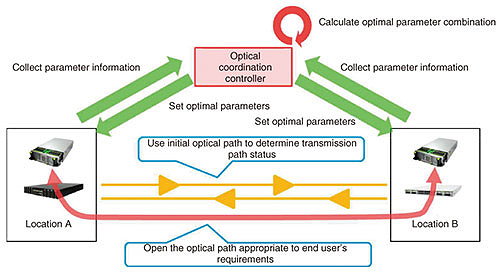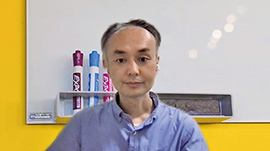 |
|
|
|
|
|
Rising Researchers Vol. 19, No. 10, pp. 11–14, Oct. 2021. https://doi.org/10.53829/ntr202110ri1  A Glimpse of the Information Communication Networks of the Future: Research on Optical Path Design for Large-scale Computing InfrastructureOverviewOne of the current challenges with information and communication networks is their lack of flexibility. It takes a lot of work to set up a new optical path between sites. Moreover, it is very difficult to establish optical paths if each site uses different optical transmission devices. Distinguished Researcher Takeru Inoue aims to configure a flexible network that allows us to freely switch between paths. Here, he tells us more about his field: optical path design for large-scale computing infrastructure. Keywords: optical path, optical cross-connect, network design Technology development for networks five or ten years down the line—What kind of research do you do at NTT Network Innovation Laboratories? The intercity relay transmission paths that NTT has constructed, managed, and operated up to now consist of optical cables and transmission devices with the capacity to accommodate the predicted traffic. In the past, when looking at the traffic in terms of each intercity transmission path, it was possible to predict this traffic to some extent. For example, traffic would gradually increase in the morning, peak at night before bedtime, and then be quite low in the small hours of the night. Another trend was that there would be a lot of communications with major search engines, popular video streaming websites, and so on. However, in recent years, user behavior has diversified, systems and devices have become faster and more sophisticated, and traffic is rapidly increasing at a rate of some tens of percent every year. Fluctuations in traffic are becoming more varied, making traffic difficult to predict, and there is growing concern that traffic will exceed the capacity of existing relay transmission paths. Until now, these concerns have been addressed through building new relay transmission paths or adding to existing ones. However, this not only takes months, but is also dependent on how accurate traffic predictions are, meaning that the same capacity shortages will occur sooner or later. This led us to the idea that, by flexibly configuring relay transmission paths to cope with these traffic fluctuations, it might be possible to further expand the possibilities of communication through things like new applications. In order to make this flexible network configuration a reality, NTT Network Innovation Laboratories is researching configuration technologies. The Transport Innovation Laboratory, which gathers experts in optical technology, is conducting research on broadband optical signal transmission by increasing the amount of light passing through a single optical fiber and increasing the number of optical pathways (cores) in an optical fiber. I’m part of the Frontier Communication Laboratory, which is researching and developing technologies for optimally switching optical signals from one optical fiber to another, and technologies for optimally switching between optical routes within a relay transmission network. Today, I will briefly introduce two of these technologies: efficient network design using optical fiber cross-connects for communication buildings, and automatic optical path provisioning. —What is “efficient network design using optical fiber cross-connects”? Consider a situation where you want to run a new optical path from a communication building to another building or company. For example, on the left-hand diagram in Fig. 1, say you want to connect the red optical fiber coming in from the bottom left to the optical fiber in the bottom right. However, the fiber cross-connect in between those points cannot be connected to the bottom right, as indicated by the three crosses. This is referred to as a “block.” The conventional approach would be to open up the network by adding another cross-connect, as shown in the right-hand diagram. However, this approach requires installing lots of expensive optical fiber cross-connects, which is not desirable from a business point of view.
We have therefore developed technology to mathematically determine the optimum number of cross-connects and their configuration. Specifically, this is a redesign of the existing standard hierarchical network structure. It allows lower-level optical signals to loop back without going via higher levels, and rather than preventing blocks altogether, we are looking for an efficient network structure where we permit them at such a low level—say, one in a million—that they will almost never occur. We made particular use of mathematics from fields such as puzzle-solving. You may have heard of things like “discrete mathematics” and “graph theory.” This technology has demonstrated that in a hypothetical network with 20,000 optical fibers and several thousand connections required every year, a five-hour calculation can reduce the number of cross-connects by 42%. —What is “automatic optical path provisioning technology”? Even if the network configuration technology for fiber-optic switching equipment guarantees that one or more destination ports are always free, it is not always possible to open an optical transmission path immediately. When the vendors of the transmission devices that transmit and receive optical signals are different, it is a prerequisite that the sending and receiving transmission devices operate as a pair. However, since specifications for anything non-standardized differ between vendors, ordinarily they will not be able to communicate. However, given the need to switch destinations, we need to be able to use a standard interface to control equipment, even from different vendors. We also need to optimize communication according to the required speed, the distance, and the quality. For example, firing a powerful laser at short distances can break the receiver. We also need to prevent interference from adjacent signals. To do this, we have developed technology that can automatically optimize the transmission mode used for communication using only standard interfaces. Specifically, we need to first understand the condition of the transmission path using the initial optical path, which is a weak signal, as shown in Fig. 2. The process is then to collect information about the parameters of communication from Location A and Location B to the optical coordination controller, calculate the optimal combination of parameters, then open the optical path according to the end user’s requirements.
These things are controlled using software. In addition to the rise of software-defined networks, there is a trend toward open source in all fields, and the current need for these technologies is increasing. While the technology for efficient network design using optical fiber cross-connects involves a mathematical approach, this one involves a software approach. Working on yet more practical technologies—What kinds of possibilities will these two technologies unlock? These technologies will make it possible to configure the network optimally at all times in response to ever-changing network conditions. I believe that the All-Photonics Network (APN), one of the three main fields of technology of the Innovative Optical and Wireless Network (IOWN), are also based on this concept. For example, although the image quality of teleconferencing systems has improved significantly over time, they are still very different from actual meetings. I personally believe that these slight delays in conversations and overlaps in speech mean there is still this sense of separation. The APN is capable of sending and receiving all the information that a human can process, so I hope that the era of just being able to manage remotely will shift to an era of not even noticing that things are remote. I also think it will be possible to use the network for applications that are still difficult at this time—things that are very sensitive to communication delays such as remote surgery. —What do you think about the future direction of your field? We talked about two technologies here, but neither of them has been put into practical use yet. It would probably be more accurate to say that we are finally reaching the start line. For example, efficient network design using optical fiber cross-connects is useful when there is a fixed number of optical fibers—but networks are constantly growing. As the network gets bigger you need to add or rearrange cross-connects, but optical signals are already traveling through them. Optical communication is more difficult to stop and migrate than packet communication, so I believe we need to find methods to expand networks while keeping them running. It’s a tricky problem. There are also challenges with automatic optical path provisioning technology. These examples I gave were limited to the setup of the two endpoints of the transmission line, the transmitter and receiver, but in reality it takes more than those to achieve optical communication. For example, above a distance of 12 to 19 miles, the optical signal becomes weaker and must be boosted with an amplifier. Additionally, to achieve optimal communication, all devices along the route generally need to be controlled together using devices such as filters. When you think, too, about the daily maintenance and operation processes, you can see this is a complex problem with a large number of considerations. Everyone working on these things has probably felt this at some point.
—What would you say to anyone hoping to become involved in information communication network research? NTT’s research environment is extremely well-equipped. It’s fair to say we have almost all the necessary equipment when it comes to information communication networks in particular. Optical transmission equipment and optical signal transmission equipment may be much cheaper than in the past, but it’s still difficult to assemble them all in a single university laboratory. At NTT, we are able to conduct research and testing using actual equipment. This is one of the major strengths of the NTT Group. When you think of information communication networks, you may picture electronic engineering, which deals with electrical signals. However, as you can see from my research, which mixes mathematics, information science, and other fields, it is an incredibly broad discipline. Of course, electronic engineering is an important area, but today’s information communication networks are more than just a means to transmit signals, so we need a variety of expertise, including the software and programming technology to manage the networks, the mathematics to back up the concepts, and occasionally, other perspectives such as economics. If you are interested in making the most of your expertise to support the social infrastructure, I encourage you to take on the challenge. ■Interviewee profileTakeru InoueDistinguished Researcher, NTT Network Innovation Laboratories. He received a B.E. and M.E. in engineering science and a Ph.D. in information science from Kyoto University in 1998, 2000, and 2006. He joined NTT in 2000. He was an ERATO (Exploratory Research for Advanced Technology) researcher involved in the Minato Discrete Structure Manipulation System Project, Japan Science and Technology Agency, from June 2011 to June 2013. He has been with NTT Network Innovation Laboratories since July 2013. He has been a visiting lecturer at Waseda University School of Fundamental Science and Engineering since September 2016. He has also belonged to NTT Communication Science Laboratories since March 2020. |



